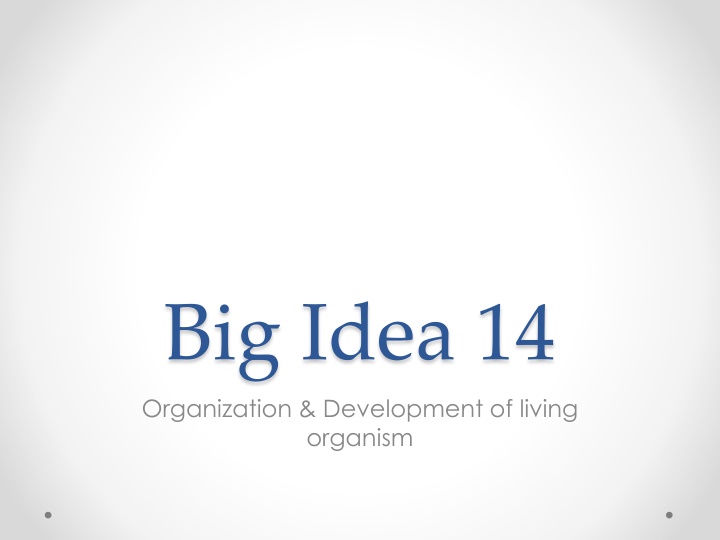
Living Organism Development: Understanding Human Immune System Protection
Explore the organization and development of living organisms, focusing on how the human immune system safeguards the body against pathogens. Delve into the essential question of how immune system parts protect us, with activities and resources provided for interactive learning.
Download Presentation

Please find below an Image/Link to download the presentation.
The content on the website is provided AS IS for your information and personal use only. It may not be sold, licensed, or shared on other websites without obtaining consent from the author. If you encounter any issues during the download, it is possible that the publisher has removed the file from their server.
You are allowed to download the files provided on this website for personal or commercial use, subject to the condition that they are used lawfully. All files are the property of their respective owners.
The content on the website is provided AS IS for your information and personal use only. It may not be sold, licensed, or shared on other websites without obtaining consent from the author.
E N D
Presentation Transcript
Big Idea 14 Organization & Development of living organism
Essential Question What and how do the parts of the human immune system protect our body from pathogens?
Objective Students will be able to explain what pathogens are and how they can infect the human body. Students will be able to identify and describe the parts of the immune system and explain how they work to protect our body .
Background Knowledge The skin is the body s first line of defense. Without the skin, pathogens would have free access. A fever is the body s way of fighting infection by creating an inhospitable environment for infectious agents. Students need to know about unicellular organisms that are too small to see with the unaided eye. Students should also know that homeostasis is the bodies attempt to maintain a consistent internal environment.
Vocabulary immune system lymphatic system white blood cell disease pathogen inflammation infection non communicable disease lymph antibodies virus T Cells phagocytes lymphocytes parasite bacteria homeostasis fungus communicable disease
Engagement 1. Why do you believe doctors tell us to wash our hands on a regular basis? 2. Where do you think bacteria grows? Complete bacteria lab. www.sks-science.com s "Biology Lab - Growing Bacteria" (http://www.sks-science.com/sciencefair/ScienceLab4.html) After bacteria lab complete Virus lab and activities. PBS s "NOVA scienceNOW: 1918 Flu" (http://www.pbs.org/wgbh/nova/teachers/activities/3318_02_nsn.html) PBS s "Ebola - The Plague Fighters" (http://www.pbs.org/wgbh/nova/teachers/activities/2304_ebola.html)(direct ions & student activity sheet)
Exploration Students will watch a short video introducing the immune system, its parts, and how they work to keep us healthy. Video Kids health: "How the Immune System Works" (http://kidshealth.org/kid/htbw/ISmovie.html) When finished, students will illustrate the human body and identify where the immune system parts belong. Writing definitions next to the organs is at the discretion of the teacher.
Explanation Have students create a vocabulary foldable in journals.
Elaboration on the web Students will read various articles on the immune system. Kids health offers a short reading passage about "What are Germs?" (http://kidshealth.org/parent/general/sick/germs.html#cat114)(with a quiz at the end of the article) or kidshealth.org s "Immune System" (http://kidshealth.org/teen/your_body/body_basics/immune.html)(lo wer level reading) NIH s "Immune System Research" (http://www.niaid.nih.gov/topics/immunesystem/Pages/default.aspx) (higher level reading)
Elaboration in the classroom Germs are not for Sharing by Elizabeth Verdick Germs Make Me Sick! Melvin Berger Achoo! The Most Interesting Book You'll Ever Read About Germs by Trudee Romanek The Magic School Bus; Inside Ralphie by Joanna Cole
Elaboration continued Students will create a 3-way Venn diagram about what they have learned about bacteria, virus, and fungus and how it affects the human body. Students are to state what remedies (if any) humans have to counteract the pathogens that infect us. Virus Fungus Bacteria
Evaluation For final assessment student will create a product of their choice researching three types of pathogens that attack the human body. Students will follow the rubric below for project.
Evaluation choices The final project choices: 1. write a letter 2. teach a lesson on what they learn/found 3. make a poster 4. make an illustrated encyclopedia page 5. write a headline newspaper page 6. create a survival guide 7. write a warning notice or community bulletin board advertising.
Project Rubric Rubric for project 4 3 2 1 0 Bacteria described: Who discovered, Side affects, Who or what can be affected, photo, Additional information Fungus described: Who discovered, Side affects, Who or what can be affected, photo, additional information Virus described: Who discovered, Side affects, Who or what can be affected, photo, additional information How is the body affected? Positive, negative, physical affects, emotional affects How is the body treated? type of treatment, duration of treatment, natural cures, in not treated Major outbreaks: what year, what happened, deaths, treatment, vaccines Creativity of final product: Color, animation, photos, interesting facts
Additional Resources www.the-human-body.net s "The Immune System - Functions, Definitions, Anatomy, Organs" (http://www.the-human-body.net/immune- system.html) Pictures of bacteria, virus, and fungus at Science Photo Library (http://www.sciencephoto.com/)
